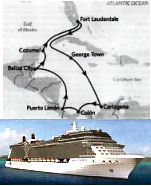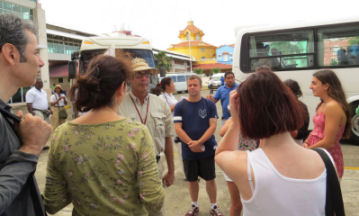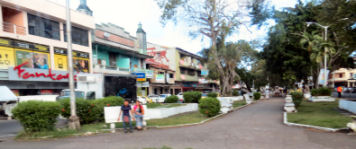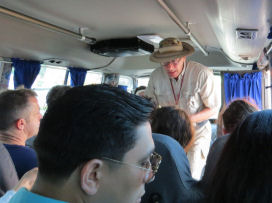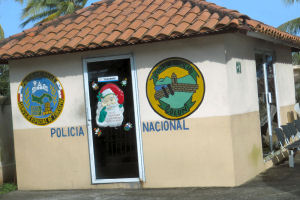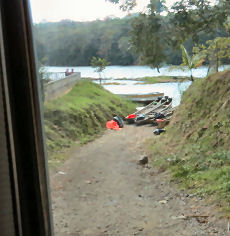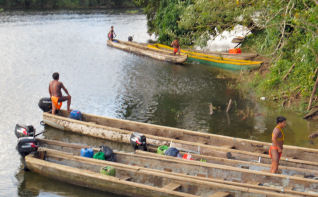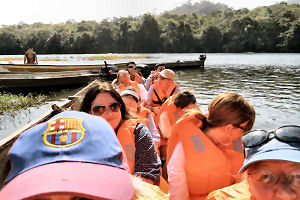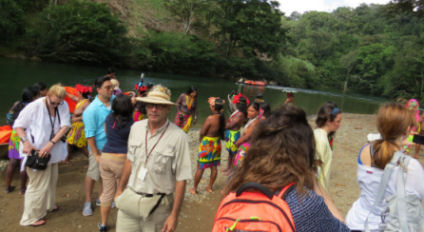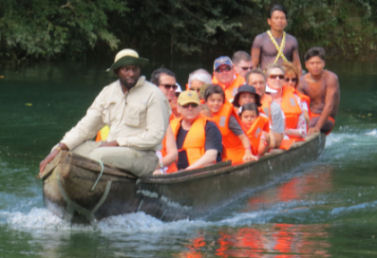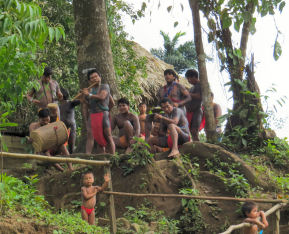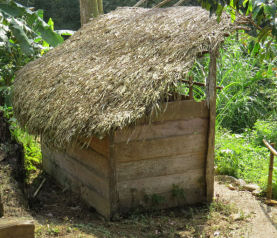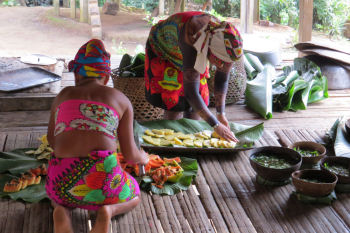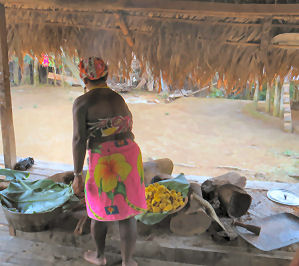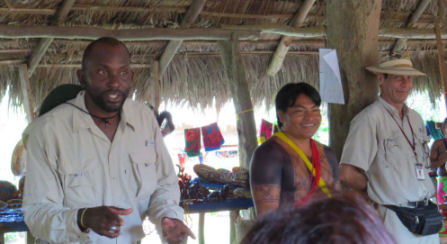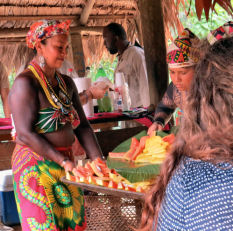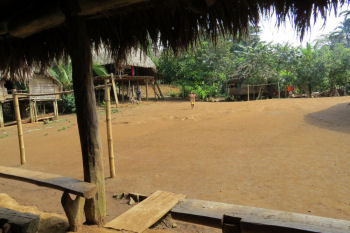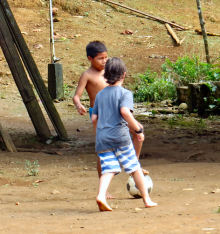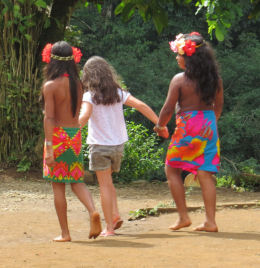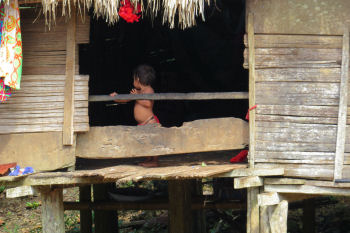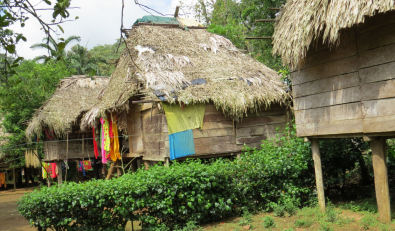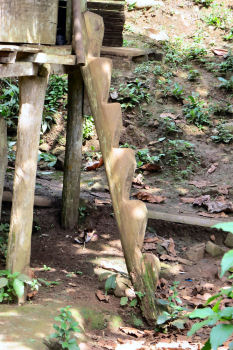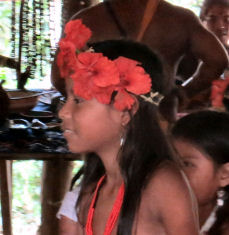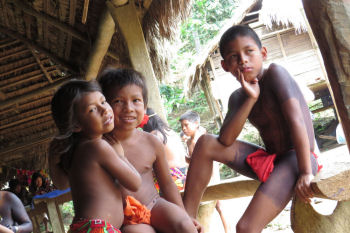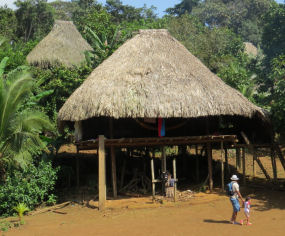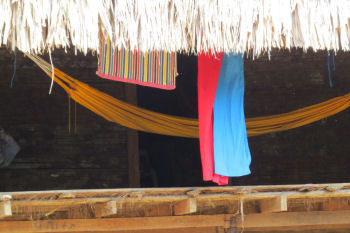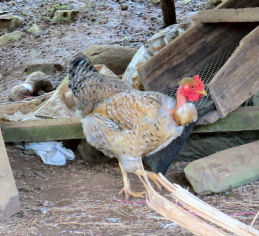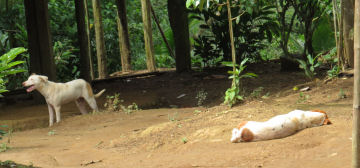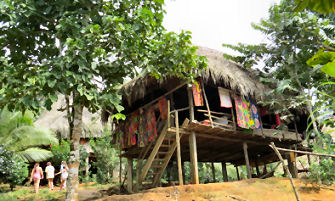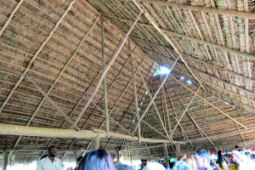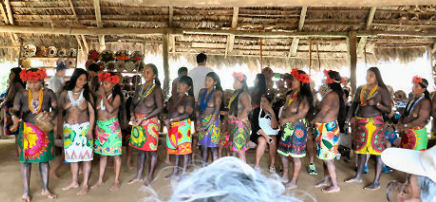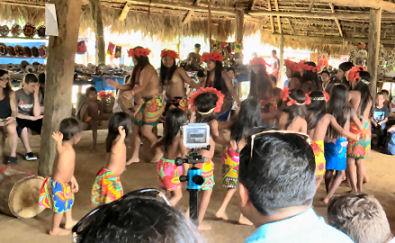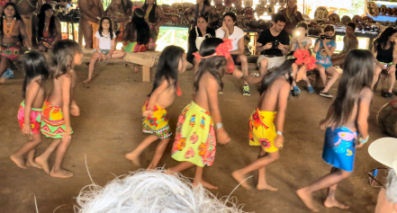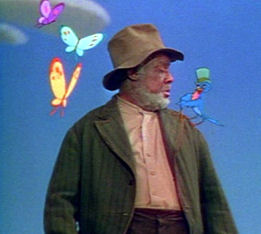
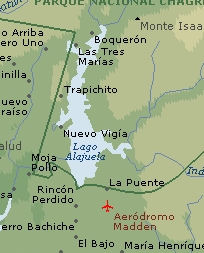
The overnight journey from Cartagena to Colón, Panamá, was much gentler than the previous night's passage. Both Sue and I awoke refreshed, and we looked forward to another day as landlubber tourists. The excursion in Cartagena had been colorful, interesting, and informative, but we had been looking forward to the excursion to the village of indigenous people in Panamá ever since we had read about it.
The plan was essentially the same as the previous day's. I began by checking my e-mail and found a nice message from Frank Evangelista. I made a mental note to inform Dave and Pogo Albig that he was still alive and cruising.
At about seven o'clock Sue and I went up to Deck #14 to eat breakfast at the café. The jogging track was dry, the sun was just appearing over the horizon, it was already warm, and the breeze was refreshing. In short, the weather was essentially perfect. I feasted on scrambled eggs, English bacon, a huge helping of peaches, fried potatoes, and coffee. We then returned to our cabin to brush our teeth and pack our day bags. We were down on the dock by 8:20.
I committed one major sin of omission that morning. I would pay for it later.
Not very many cruisers had signed up for our excursion, which for some reason was called Grand Circle. We gathered around a guy who appeared to be dressed for a safari. He spoke English very well. However, his flamboyant and overly friendly manner really put me off. He asked everyone where they were from, and he thereafter referred to them by that place. Sue and I became "Connecticut," as did another couple who were originally from New Britain but had moved to (where else?) Florida. The fellow from New Britain had a camera just like my Canon SX50 HS. Someone else became "England," and a couple was thereafter known as "Puerto Rico."
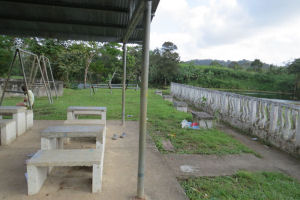
I think that it was the fellow's remark about loving to party in Chicago that really turned me off I was fervently hoping that there would be a second guide, and we could gravitate into his group. It did not happen. We boarded the first small bus, and the guide, whose name was Manuel, took his place in one of the front seats.
It was a long bus ride, and Manuel used the time to tell us about himself, Panamá, and the Emberá people. He introduced himself as a teacher at a local university. His parents had both worked for the United Fruit Company – Chiquita bananas and all that – in Cuba and Panamá. He grew up speaking English and Spanish. He had been to the United States many times, and he currently taught English to prospective tour guides and others in the hospitality industry. His English was not only flawless; it was also idiomatic and nuanced.
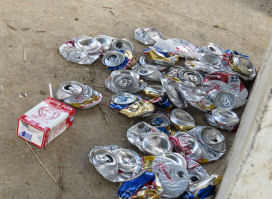
Manuel told us that for the last twenty years he had been working with the Emberá, an Amazonian tribe that settled originally in Colombia. The ancestors of the people whom we were about to visit had migrated to eastern Panamá from Colombia some years ago. This Emberá village was in the Chagras National park. The inhabitants were allowed to fish as much as they want, but they were not allowed to hunt the animals in the forest.
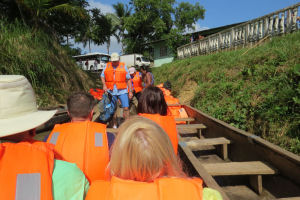
After he had been speaking for only a few minutes, my attitude about Manuel changed completely.[1] He obviously respected the Emberá people greatly and had over the last two decades helped them to create an auto-sustaining lifestyle. He emphasized that today's visit would not be like going to Disney World. This would not be a show. The inhabitants of the village would be treating us as guests, not customers.
Manuel taught us a few words of the Emberá language. He did not spell them; I wrote them down as they sounded to me. The Emberá word for friend was chava, but the Emberá word also included people with whom one was merely acquainted. Nevertheless, Manuel considered it closer to "friend" than "acquaintance." The leader of the village was called the nokó. The shaman was referred to as xaimaná. The word for their dwellings – one room open-sided wooden structures with thatched roofs built on stilts – was something like tambo, but I neglected to write it down.
The Emberá language uses clicks and rolls. We heard a few people sing or chant, but I did not detect any clicks. The speeches made by leaders of the village were all in Spanish. I did not overhear any of the Emberá speaking among themselves.
All children in Panamá, including the Emberá, are required to go to school, where they learn, among other things, the Spanish language. For the first few years the instruction is given by an outsider at a structure within the village. After they are old enough for middle school, the children must make the same long trip by canoe that we would be taking. When they arrived at the landing site, they would still face a lengthy ride in a motor vehicle. In the late afternoon they would need to make the same trip in reverse. Both within the village and at the school the children were required to wear uniforms. On all other occasions – including our visit – they wore their traditional dress, which consisted of a loincloth for the men and a wraparound skirt for the women. Some of the women also wore something on their torsos.
Medical care could pose something of a problem. The xaimaná provided some traditional herbal remedies, and occasionally an official from the government visited the village. In case of an emergency, the subject must be transported by canoe to the landing and then by truck, car, or taxi to a city.
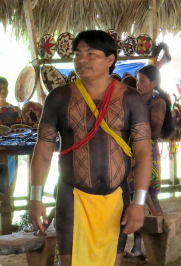
The religious views of the Emberá people seemed to be rather simple. They worshiped nature, and they gave thanks for everything that nature provided them. If they shared any outlandish beliefs concerning the source of the universe, the origin of their people, or life after death, Manuel did not tell us about them. He did note that this region of Panamá had been targeted by Protestant missionaries. I assumed that he referred to fundamentalists.
Manuel told us the story of a lady from Massachusetts[2] who married an Emberá man some years ago and currently lived in one of the villages. It was hard to believe, but he said that she had started a very successful tourist business that arranged for people to take whale-watching excursions in the Pacific Ocean.
As the bus had proceeded through the city, I noticed that Colón was, in Manuel's words, not very beautiful. The highway, however, seemed quite modern. Evidently the national government had invested more heavily in infrastructure than in urban renewal. In one sense, this was a little surprising. Colón was the entry spot to the country from the east and north; in fact it was the third largest port in the world. It seemed like it would be a worthwhile investment to spruce it up a little.
As we passed some fields with skinny trees that had obviously been planted at intervals, Manuel explained that there was a new project to grow teak, a very valuable hardwood that is not native to the new world. Investors were able to purchase undeveloped land for only $2,500 per hectare. Of course, there were restrictions, and incentives, but the program has been rather successful at attracting capital. These investments certainly require patience; it takes 40 years or more for the trees to grow to the size at which they can be harvested.
Manuel insisted that the best bananas in the world come from Panamá. He specifically told us not to believe claims to the contrary in our next stop in Costa Rica.
Someone on the bus asked Manuel about wildlife in the rainforest. He said that there were rodents, snakes, and wild cats of some kind, as well as thirty-two species of toxic frogs. He also related that for two months out of the year the Panamánian skies were filled with the migration of turkey vultures. Last year there were an estimated three and a half million of them. That is roughly nine birds for every ten Panamánians. That must really be something to witness.
The bus ride lasted for almost ninety minutes, and the scenery was not inspiring. However, Manuel's discourse made it anything but tiresome. We finally stopped at a landing used by the Emberá. We had to wait there for fifteen or twenty minutes until the other group, which was led by a guy named Antonio, arrived. The landing was not a pleasant place, but it did allow us to see the Emberá canoes and their drivers. The boats were long and obviously very sturdy. The men were uniformly short, squat, and barefoot, and many of them had decorated their bodies in various places with a kind of ink derived from the jagua plant. I did not notice any of the tourists trying to converse with them. Maybe no one in our group knew Spanish, or maybe it seemed intrusive. It also is possible that the school requirement had been implemented after the drivers had become adults.
We were all outfitted with life jackets. Manuel wore one, but the Emberá driver did not. The boat trip across the lake[3] and up the river[4] was interesting. Plenty of birds were visible. The canoe was equipped with an outboard motor, and it plowed right through the seaweed or algae or whatever it was that often appeared on the surface of the water. The most amazing part of the journey was the beginning. The operator of the canoe walked up the gunwales from the rear to the front as quickly as if he was walking on a wooden floor. He then made the same trip in reverse. These guys obviously had a great sense of balance, and they knew their canoes.
When we arrived at the village we disembarked from the canoes as some of the Emberá played a tune for us. We had to climb up the bank, but after we did, we were immediately welcomed into the village. They had glasses of chilled water and Coke Zero ready for us, as well as cheese sandwiches. That was a surprise.
We had learned that 138 people resided in the village, which consists of twenty-eight houses and three common buildings – the one at ground level is used for meetings and other gatherings, the raised one is where the cooking is done, and, I think, the third one is a latrine.[5] In the middle of the village is a large open area. At either end were small improvised soccer goals. Some of the Emberá children were kicking a soccer ball back and forth. It took less than five minutes for some of the younger tourists to join in their game.
Since the houses were on stilts, entry and exit was done by climbing up and down logs that were set against the floor at a steep angle. The logs had right-angled notches in them so that they could be climbed like very narrow stairs with no railing. At night the logs could be withdrawn into the houses to prevent critters from entering during the night.
The area below the houses was used to keep things dry. Under many of them chickens and/or dogs took advantage of the shade. The dogs were remarkably tolerant of the chickens.
The leaders of the village – one male and one female – gave little speeches of welcome in Spanish. Antonio and Manuel took turns translating their remarks into English. We were then served a lunch that the Emberá ladies had prepared in their elevated kitchen. The main course was fried fish and fried plantains served in a large envelope made from some kind of leaf. Both were hot and delicious, but even more delectable were the fresh pineapple and papaya that were served as dessert.
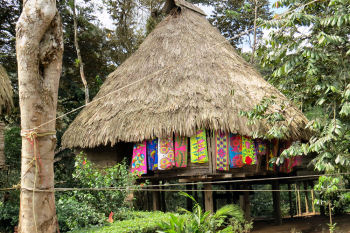
After lunch the tourists were allowed to wander around the village and do anything that they wanted except to look into the houses. This requirement was hardly restrictive, as most of the houses had one end that was open to the air.
The finale was musical. A little all-male band played some tunes; the female leader led all of the ladies – including a couple of tykes – in two dances, the dance of the monkey and the dance of the xaimaná. Then almost everyone – including the tourists – joined in an elegant dance that was reminiscent of something from Mozart's day. Sue took movies of the dances. I shot a large number of still photos, but this is the point at which I was punished for the aforementioned sin of omission. I had neglected to recharge the battery in my camera, and for the first time ever it ran out of juice. I had planned on taking some nature photos of the return trip, but I was unable to do so.
After the dance twenty minutes was allotted for shopping, an activity that interested me not at all. Since my camera was no longer working, I used the time to jot down notes in my notebook. Sue bought a few things to give to her sisters for looking after Giacomo in our absence. Manuel had asked us not to haggle about prices. Each family displayed its own merchandise, mostly intricate bowls made from reeds and carvings, and they priced each item based on the amount of time it took to produce.
The canoes were reasonably comfortable, but our Yankee butts were not accustomed to sitting on wooden benches for extended periods of time. Halfway through the return trip the lady sitting in front of me doffed her life jacket and used it as a cushion. My buns envied her ingenuity, but I lacked the temerity to emulate her.
The excursion was extremely interesting, educational, and fun. I probably should have taken advantage of the opportunity to interact with some of the Emberá, but that sort of thing does not come easily for me. Manuel did not lecture on the return trip, but I was close enough to the front of the bus to overhear his conversation with one of the ladies. He told her that the Emberá received about 85 percent of the fees that we paid to be on the excursion. If that is true, then they may indeed have happened upon a way of maintaining most of their traditional lifestyle in the twenty-first century, or at least the first part of it.
As the bus approached the pier, Manuel surprised everyone. He asked us all to sing a song, "Zip-a-dee-doo-dah." I don't think that he appreciated the irony of singing this particular song after emphasizing the authenticity of our excursion. On another level, however, it seemed absolutely appropriate. Even I joined in.
When we arrived back at our cabin, I watched a little of the New Era Penstripe Bowl between Penn State and Boston College. When I went down to the dining room for supper it was tied. [6]
At supper Larry Fleer, a Nebraska alum, complained that he feared that he would not be able to watch the Cornhuskers game with Southern Cal because the ESPN signal had repeatedly been cutting out. By the way, I had discovered that the left side of the menu – which did not change – had some very good offerings. I was especially enamored of the escargot and the French onion soup.
Everyone noticed the extremely high volume of maritime traffic as we departed from Colón and headed west to Costa Rica. The southern Caribbean will probably get even busier when the new canals are operational.
Sue and I somehow finished second in the evening game with a 59 percent score. There was one OBAR BIDS hand.[7] After the game Sue and I purchased $9 Scotches and tried to go over the hands in some very dim light. We later discovered that we could have easily found much better lighting and much more comfortable chairs a few yards away.
My most important duty for the evening was to make sure that the camera battery was charged. The lights in the room were on a master switch, but the one electrical outlet worked even when the master switch was off. So, I was confident that it would be fully charged by the time that I awoke.
We had to set the clocks back overnight. We therefore enjoyed an extra hour of sleep that was mostly free of agonizing over bridge hands.
[1] One of my debate coaches used to tell me that appearances count for 10 percent. She had no answer when I asked her, "10 percent of what?"
[2] Her name is Anne Gordon de Barrigón. Her tour company provides a lot more than whale watching. The website is http://www.emberavillagetours.com/.
